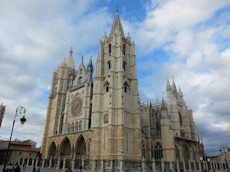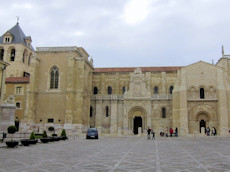León was founded by the Romans in 68 AD as a base for a legion. For a long time, León was the capital of the Kingdom of León, an important precursor of the Spanish state. Today, León is the capital of the province of the same name.
León is famous for its Gothic cathedral, the Basilica of San Isidoro with the Pantheon of the Kings of León or the Casa de Botines, an early work by Antoni Gaudí.
Some remains of the former Roman city wall have been preserved.
On the map, the city wall is marked in red. Photos are hidden behind the orange dots. They become visible as soon as you move the mouse over them. To visit the cathedral or San Isidor, click on the picture.

León was always an important stop on the Way of St. James to Santiago de Compostela. Merchants and artisans settled in the suburbs and strongly influenced the development of the city from the 13th century onwards.
The walled enclosure was expanded by the León kings Alfonso V and Alfonso IX. The only surviving archway, Puerta Castillo, is located on the north side of the walled enclosure In the same area, in calle Carreras, we can visit a long section of the Roman fortress. However, its towers were demolished at the end of the 19th century. Fortunately, in its eastern part, on Avenida de los Cubos, there are still some preserved Roman towers, which were enlarged in the 14th century.
Near the cathedral was a city gate that was not demolished until the 19th century, the Puerta del Obispo. Remains of the Roman gate can be seen in a specially built archaeological crypt.



